Popular on Food52
Continue After Advertisement
29 Comments
Jc H.
August 5, 2018
Recently I discovered how to make caramels with honey and icing sugar...the only thing i'm struggling with is how to get them all in a bag without sticking to each other in one day. I tried icing sugar but at the end of the day the caramels absorbs that and they go sticky again. Anyone with a great tip?
Raquelita
August 15, 2014
I used to be able to make caramel! In my adult life, I have had a terrible time. I wonder if it's a difference with the sugar I use. I used to use plain white sugar, with the pristine white color. Nowadays I use a cane sugar (not sugar in the raw) that comes from the bulk bin at the natural foods store. Is the residual molasses that makes my sugar "blonde" and not white messing things up? I can get the sugar to liquefy and then it crystallizes and seizes. Each time I can add water and get it to melt, but the crystals that seeded the first time continue to make it seize when the water evaporates. Is this a sugar issue?
Laura415
August 16, 2014
I've used both the white and the blond organic cane sugar. They both work fine. I don't know the recipe or method you are using but I use the melt the dry sugar method and don't add liquid until I add the cream. You also don't want to stir caramel too much. That can knock a crystallized piece off the side of the pan causing the whole thing to seize. I also often use a little honey or corn syrup because some of my recipes call for it. I wonder if that little bit of syrup keeps the crystallizing to a minimum. Good luck and keep trying. No matter what, as long as you don't burn it it will taste good and you can use it for something. (If it's un-salvagable as caramel I usually make caramel ice cream with it)
Laura415
October 24, 2013
In the quest for the best homemade caramel I have found the following fixes possible: If your caramels come out too soft you can remelt and bring to temperature and re pour them. It's a matter of cooking the excess liquid out that is keeping them from setting up correctly. Same thing for caramels that come out too hard like sugar daddys. Chop and remelt then add a little cream to put back liquid that was accidentally cooked out the first time. Finally, using honey as part of your sugar is really tasty and if you have honeycomb add some to your mix. I think the beeswax helps the caramels set up better when the wax solidifies. (not talking about a lot of wax just a bit) Also in some batches with honeycomb there is a pleasant crunch from little bits of honeycomb in the caramels.
It's not a beginners bag of tricks, but when push comes to shove and you don't want to dump the batch I've tried both these fixes and they both worked perfectly.
It's not a beginners bag of tricks, but when push comes to shove and you don't want to dump the batch I've tried both these fixes and they both worked perfectly.
Cristina K.
August 12, 2013
Love this! Love this method too:http://nobakemakery.blogspot.com/2013/08/2-dish-microwave-caramel-happy.html
petrini.elisa
November 14, 2012
all these baking tips are FANTASTIC!
THANK YOU! a much-needed pre-holiday post!
THANK YOU! a much-needed pre-holiday post!
UglyButDelicious
October 25, 2012
So you are supposed to cook until it starts smoking? I thought that if it was smoking it meant it had gone too far. A few weeks ago I was making a few batches of caramel and one of them started smoking, and then after it had a burnt bitter aftertaste. Some people like that but it wasn't what I was going for.
Kenzi W.
October 25, 2012
To achieve a deep, reddish-brown, yes. But it's all about preference -- if that tastes burnt at all to you, feel free to stop the cooking sooner. Also make sure you're using your pot with the heaviest bottom, as that will help you have more control over how fast your caramel cooks. (Read: it won't run away on you and burn!)
UglyButDelicious
October 25, 2012
Great, thank you. The first time this happened I was actually using an enameled cast iron pot, which I think was too heavy--I took it off the heat when it looked done, but then it kept cooking from the residual heat in the pan! The recipe I was using said to wait a minute before adding in the cream, so while I was waiting it went ahead and burned anyway. Live and learn! I think I am getting the hang of it now though. As you said, it's really about experience and not relying on a recipe.
ThereseTetzel
October 18, 2012
I made this caramel yesterday and put it in a glass canning jar in the fridge overnight. It's actually better today. The flavor has intensified and it has set up to be a paste. Really wonderful. Thanks for the recipe.
saltandserenity
October 18, 2012
This is a great primer on caramel, making. Thanks for sharing!
If anyone is looking for a great recipe for dipping apples, I have made this one many times and it is wonderful!
http://saltandserenity.com/2011/09/28/a-very-sweet-new-year-with-caramel-chocolate-dipped-apples/
If anyone is looking for a great recipe for dipping apples, I have made this one many times and it is wonderful!
http://saltandserenity.com/2011/09/28/a-very-sweet-new-year-with-caramel-chocolate-dipped-apples/
ThereseTetzel
October 17, 2012
Is this the best caramel for coating apples? If so, is there a best way to prepare the apples? I made this caramel and it is very easy and very good but it is very thin. I assume it gets thicker as it cools? How would you alter this recipe for other sugars such as lite brown, dark brown, turbin ado, and unprocessed cane sugar? When do you add other flavoring a like bourbon or maple? Is maple syrup a substitution to sugar? Thanks so much, Therese
Kenzi W.
October 17, 2012
The caramels I've seen for coating apples usually have more ingredients than just your standard sugar, butter, and cream. I suppose you could try this one (and yes it does thicken as it cools), but from what I've read, you might be better off with a recipe for caramel apples. (Simply Recipes has a decent, straightforward one.) In these types of recipes, maple syrup is mostly just used as a flavoring agent, meaning you need the actual sugar in there to do the bulk of the caramelizing work. All of this talk and I officially want a caramel apple -- best of luck with yours!
abbygayle
October 17, 2012
How much salt would I add to make salter carmel. When is it added?
Kenzi W.
October 17, 2012
There is a lot of flexibility in salted caramel. You could use salted butter in your sauce, or you could add it just when you stop cooking so it melts, if you like -- if you're using 1 cup of sugar, I would start with 1/2-1 teaspoon, but this really depends on your taste. You could also sprinkle a flaky salt over the finished sauce (that way you get a texture contrast).
cara592
October 17, 2012
I've made caramel lots of times for a bread pudding topping. It's actually pretty easy, so if you are having issues, I think you are stirring it too much, or messing with the sugar-heating process in general. Joy of Cooking has a very good caramel recipe and the secret is (which I have learned by messing it up), DON"T MESS WITH THE SUGAR. Occasionally swirl the pan around on the heat , but your spoon doesn't even need to go in there until the very end to blend the butter and cream.
Meisen
October 17, 2012
Why does my caramel sauce crystallize when I put it into the fridge? It's fine when I first make it, but when I take it out to reheat (usually in the microwave) in the following days, I get small granules of crystallized sugar throughout the sauce.
Kenzi W.
October 17, 2012
It may not be the fridge -- the problem could be happening in the first stage, if all of the sugar crystals failed to melt, or if there were any left over on the side of the pan. A trick I've read for the latter is to dip a pastry brush in water to "scrape" down the sides of your pan.
It could also be something as simple as the shelf life -- sometimes the sugar in caramel will crystallize if it's been stored too long, so just make sure you eat it up quickly!
It could also be something as simple as the shelf life -- sometimes the sugar in caramel will crystallize if it's been stored too long, so just make sure you eat it up quickly!
Meisen
October 17, 2012
Thanks Kenzi!
I use the pastry brush and water technique myself. I try to bring the sugar temp to between 350-360 before I add the butter. I don't keep the sauce longer than a month in the fridge. I have heard that adding corn syrup to the sugar will prevent crystallization. What do you think?
I use the pastry brush and water technique myself. I try to bring the sugar temp to between 350-360 before I add the butter. I don't keep the sauce longer than a month in the fridge. I have heard that adding corn syrup to the sugar will prevent crystallization. What do you think?
Kenzi W.
October 17, 2012
I've read that the corn syrup trick works in a lot of places! I like to avoid any extra ingredients when I make caramel, but if you're having trouble with the crystallization, I say go for it.
Greenstuff
October 16, 2012
Harold McGee's most recent blog post is about caramelization. Check it out at http://curiouscook.com/
chelswa21
October 16, 2012
Is there a list of ingredients and proportions that I have missed? Thanks for the article - I over mixed my dry caramel and fashioned some impressively cement-like sugar flakes.
Kenzi W.
October 16, 2012
That's the worst! But totally fixable. A lot of recipes differ, but I have a standby sauce: melt and caramelize 1 cup of sugar, and when it gets to your desired color, add in 3/4 stick of butter and a half cup of cream.
BurgeoningBaker
October 16, 2012
So here is my question/comment. When I make caramel in either fashion, something goes awry. When I pour the cream into the caramel and stir the two never mix. Instead what I get is a lot of liquid and crackling hard caramel fixture around my mixing utensil. What is causing this and how do I prevent it from happening?
Kenzi W.
October 16, 2012
Hm, that's a tough one. I would try making sure that your caramel is still very hot and fully liquid when you add the cream -- if it has had any chance to cool, it will start to seize up. You could also switch to a whisk at that point as well, which will help you incorporate your ingredients if they decide to be a bit stubborn.
brockbier
October 16, 2012
That ALWAYS happens to me. I typically turn the stove off, but leave the pot on the burner for residual heat. As the cream in the mixture heats up, the caramel will eventually melt and your sauce will be complete!
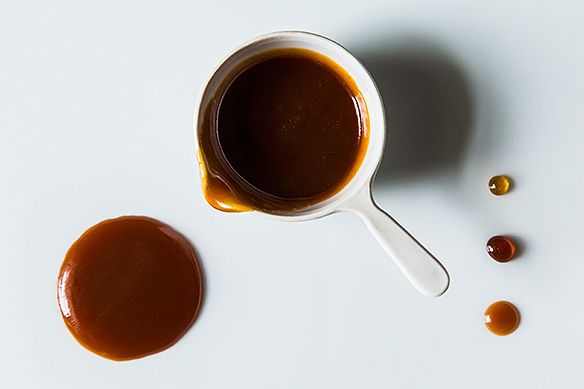


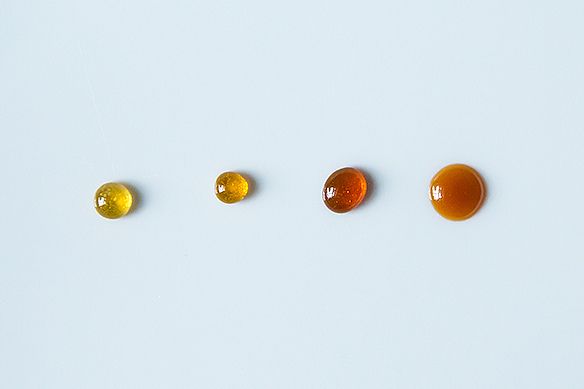
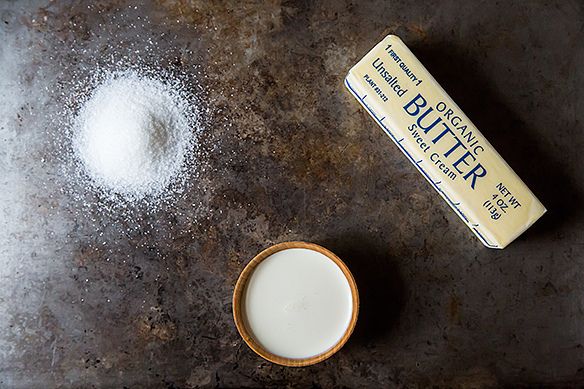
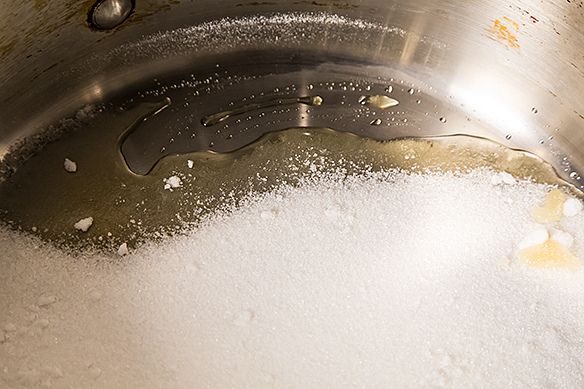
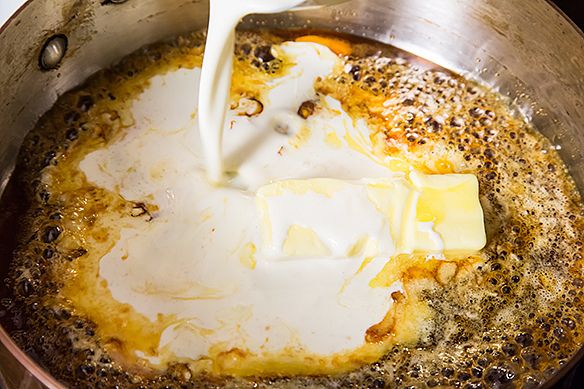


See what other Food52 readers are saying.